Our Final Video
OUR FINISHED ALBUM COVER
Tuesday, September 28, 2010
My Group
Marketting & Distribution

Michael Buble has a new single out, 'Hollywood', which we can see at once from the advertising strip towards the top of the page. A striking photo of Michael Buble is what stands out at first though from the page, and his name in a simplistic yet bold font. The whole colour scheme is quite neutral, with lots of browns, greys, and blacks and the text of his name in a white font which stands out against the background. The single itself, Hollywood, and the previous album he has released, are both quite laid-back and calming themselves, so this matches the whole image he has created for himself on his website. He is dressed smartly and freshly, in grey white and black, so his clothing matches the colour scheme and his 'slick' image. The colour scheme and simplicity of the design continue for the whole website.
Because of the smooth, romantic nature of Michael Buble's music and his attractive, clean-cut image the assumption is that the main target audience would be females, but from a male-perspective, he is also quite an aspirational figure, so men could also be targeted. The colour scheme is quite masculine, whereas the focal point is the picture of Buble, so both genders could be taken into account.
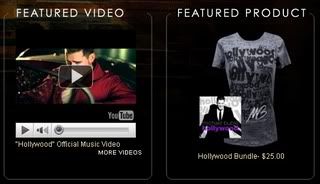
In the top right hand corner of the website are synergies with websites Myspace, Facebook, and Twitter, and slightly further down the page YouTube, showing the wide reach Buble would have with this website, specifically to a younger audience. Younger audiences are targetted further with the inclusion of a "featured product" which advertises fashionable clothing up for grabs if you purchase his single.
Michael Buble's music however does also appeal to a more mature audience, for example men and women in their 30s; endorsment on his website includes free calenders, and concert tickets as well, and the whole image is quite serious and sophisticated, and not as loud, and in-your-face as more poppy music websites aimed at teenagers.
The whole website is relatively uncluttered, there are very few deals on offers or promotions being shoved in your face, the sole focus seems to be Michael Buble and his music, for example dates of tours etc. Reprise Records backs Michael Buble's new single and the website, which is included in quite small print at the bottom of the page. There are no other institutions advertised (for example on Taio Cruz's website, River Island is endorsed), suggesting that the company/Michael Buble himself do not need the extra money from advertisements and promotions.
Thursday, September 23, 2010
Tuesday, September 21, 2010
Initial Idea
- After messing around with some of my previous initial ideas, this is one of my favourites.
- Little Boots, Meddle is a song that hasn't reached the charts and doesn't have any existing copyrighted music videos on YouTube.
- Lyrics such as 'don't go messin with a heart or messin with a mind', 'I'm a mixed up girl in a mixed up world' imply that the singer is in emotional turmoil
- We could continue the theme of disorder, and of the artist's head being in a mess by shooting our video in reverse, which would create the effect of a mixed up or crazy world. For example, if we were to film our main character walking backwards, and everyone around her walking forwards, this when played in reverse would have the effect of her walking forwards whilst everything surrounding her is backwards.
- We would have to be careful that it would not look tacky, or that it wouldn't be too difficult to accomplish within the time constraints and other restrictions regarding equipment etc., but it has been done before and is certainly possible given the correct time and planning.
- Spike Jonze's' music video for The Pharcyde, 'Drop' is shot entirely in reverse and has an effective end result, as is Coldplay's the scientist. (http://www.youtube.com/watch?v=WcX7Zweqgc0&feature=related, embedding for this video is disabled).
Monday, September 20, 2010
Vernallis Analysis
- Narrative
- Editing
- Camera Movement and Framing
- Diegesis
Justin Timberlake - Cry Me A River
- Narrative
2. Editing
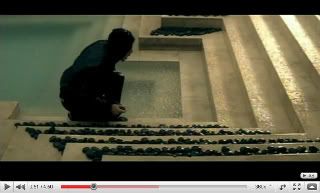
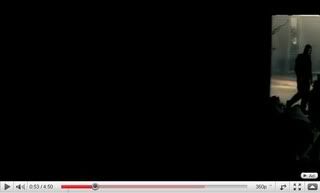
(an example of a jump cut, from one shot to the next)
The editing matches the lyrics/beat of the song, and there is very little continuity (which is a clear convention of music video editing). There are jump cuts quite regularly throughout at the end of a line of the song or on the beat. The editing can be referred to as 'foregrounded', where it is really obvious as oppose to the invisibility of continuity editing. Although there are some smooth transitions used, for example when he enters into her house, far more often there are jump cuts, breaking of the 30/180 degree rules, cutting against the movement, extreme jumps in time and space, and juxtaposed frames.
3. Camera, Movement and Framing

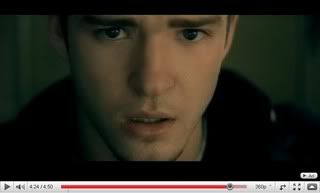
According to Vernallis, when it comes to camera framing, common conventions in music videos are extremes, for example Extreme Close Ups or Extreme Long Shots, both of which are true for Cry Me a River (extreme close ups or 'beauty' shots of Timberlake's face and master shots are cut to frequently, as pictured above). The camera also moves in time to both the lyrics and the music throughout.
4. Diegesis
Vernalli's theories about Diegesis are as follows:
- The diegesis can be revealed quite slowly
- Actions are not necessarily completed
- Characters/object movements may move to the music
- May be gaps in the audience's understanding of the diegesis - in time and space, music, performance, and narrative
- Some frames may be more important than others
- May be many repetitions
Goodwin Analysis
Lil Wayne - Fireman
Hip-Hop/Rap Genre
1. Music video demonstrates genre characteristics (eg. stage performance in metal video, dance routine for boy/girl band)
Both the visuals and the lyrics demonstrate the songs' genre. There is a lot of objectification of women (shots of women in short shorts etc., shots of his gaze following women as he passes them as though checking them out). Lil Wayne is dressed in a typical hip-hop star fashion, with low slung trousers, baggy t-shirts, sunglasses, 'bling' such as big watches, earrings, chains, the band of his boxers displayed just over the band of his trousers. His dancing is hip-hop style also, he uses his hands a lot, shaking them in time to the beat at the screen at one point. There are no instruments at all.
2. There is a relationship between lyrics and visuals (either illustrative, amplifying, contradicting)
The lyrics are quite abstract and I don't understand a lot of them, but from what I understand him being 'the fireman' is symbolic of the power he commands. All the girls want him, he can throw away money ("money too long teachers put away ya rulers"), his life is effortless and he commands respect ("Everything is easy baby"). One of the lyrics states: "I don't even need a G-pass, I'm past that". He's saying he's well-known and powerful enough that he doesn't even need a 'G-pass', in other words a pass for gangsters. The song is all about him, and his return, and the fact that though he hasn't changed, he has come back better.

His message is reflected in the visuals which I would say are amplifying - they are not entirely illustrative as there is not an exact story-line to illustrate and they do add new layers of meaning to the song, however they do follow some of the main, core lyrics. There are shots of the girls that follow him, CUs of their bums, of him dropping money onto the floor as if it means nothing to him, of him rapping surrounded by fire, striding around in a powerful and commanding way. At the beginning it also striding in through a door and walking up a corridor and dressing himself as he raps 'I'm back'.
3. There is a relationship between music and visuals (either illustrative, amplifying, contradicting)
4. The demands of the record label will include the need for lots of CUs of the artist (visual hook), and the artist may develop motifs which recur across their work (a visual style). These inclue CU of the star's face (the 'money shots'), iconography of band image, visual trademarks/motifs.

Lots of CUs of Lil Wayne are included, either pointing or shaking his hand at the screen as he raps, and also a lot of money or 'beauty' shots - CUs of his face. After doing a bit of research into Lil Wayne I also found out that, although not included in this video, Lil Wayne's trademark in a lot of his work is a red bandana either tied around his arm, head, or tucked into his pocket, which is evidence of Lil Wayne as an artist developing an identity for himself.
5. There is frequently reference to the notion of looking (screens within screens, telescopes, etc.) and particularly voyeuristic treatment of the female body)
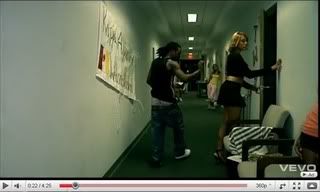
There is heavy emphasis on the female body in this music video. It is implied that a lot of the women in the video are prostitutes or hookers, and there are lots of CUs of bums, stomachs, and breasts. Not only this but the women are scantily clad, and the camera seems to follow their bodies. As well as frequent shots of him looking at or checking out women, they seem to be checking him out in a lot of the shots as well, so both him, as the artist, and the women involved in the video are on sexual display.
A lot of the looks exchanged between him and the other characters seem to be quite suggestive.
Lil Wayne looking directly at the camera as he raps creates an emotional connection between him and the audience.
6. There is often intertextual reference (to films, TV programmes, etc.)
Intertextual references in this music video inclue:
- Draw McGraw: a cartoon character who was a sheriff in the old West.
- Cash Money Records (his record label), "Where dreams come true" (referrencing Disney)
- Jordan and Peyton: Michael Jordon, Peyton Manning, notoriously driven and intense athletes
- Toucan Sam: the mascot for Fruit Loops
Genre Analysis
The White Stripes - Seven Nation Army
Rock Genre. Follows the conventions of:
- Big focus on the instruments
- Instruments are stereotypical of the rock genre for example a drum kit and a guitar
- Dark colours: black, red (juxtaposed against white, but predominantly a darker feel)
- Builds up to a louder, more rocky chorus
- Lots of cymbals, electric guitars, flashing lights
- Although the style of dressing/haircuts isn't clear throughout, the male in the band is wearing a tight T-shirt and has long hair, both stereotypical of the genre
Eminem - When I'm Gone
Rap Genre. Follows the conventions of:
- Stereotypical rapper-style dress
- Caps, bandana around his head, baggy jacket, hoodie, tattoos, baggy t-shirt, tracksuit bottoms.
- Towards the end when he appears on stage, it's just him and the microphone, which is not on a cord/stand, and he holds in the style of a rapper (although conventionally the tilt the base of the microphone upwards).
- Hip-hop/rapper style dance moves, shaking head and hands etc.
- No focus on instruments
- Crowd dancing in time to the beat of his music, bopping their heads etc.
- Lyrics tell a story, typical of the rap genre, which is also commonly about the rappers own life, as with this example.
Monday, September 13, 2010
It's Not Me It's You
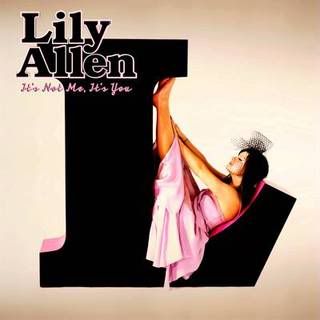
Lily Allen is pictured on the front, sitting inside a large 'L' shape. She takes up about half of the cover, and is centered. The colour scheme is simplistic, just black, baby pink and a beige backdrop. Her name and the title of the album 'It's Not Me It's You' are in the top left hand corner, with her name in a much larger font. The baby pink and the beige work well in making the black L really jump out of the cover so that even if you were just glancing it at it you'd see it straight away. The way Lily Allen is curled up inside the L looks quirky and cool and in-keeping with the fun and playful mood of the album, and her name in the top left hand corner stands out because of it's thin pink outline.
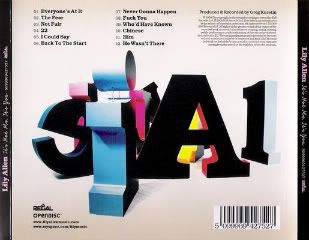
There is more going on on the back, although the main theme carries through: the beige back drop, pastel colours, large 3D letters jumbled around, and black as the main colour. The font is also consistent, and the tracks are listed in the top left hand corner in two columns. The bar code is in the bottom right hand corner, and the names of the record companies etc. are listed in the bottom left hand corner. The spine is black, with her name and the album title written in baby pink. If someone has stopped for long enough to look at the back cover of the CD it means they're definitly interested in buying it, so they can afford to have more information on the back. Even so, it is kept simple yet bold, with just two more colours introduced, still pastels, and is still in keeping with the fun, light-hearted theme.
What I think is so effective about this album cover is it's simplicity and slight quirkiness. It's not overdone with effects and loud colours, there is just a simple but eye-catching colour scheme, and a design that grabs your eye at once. You immediately know that it's Lily Allen's CD, her photo and her name are used as the selling point on the front, and the colour scheme matches the playful mood of the album. The 3D letters are also something slightly different and interesting that set the album cover apart.
Sunday, September 12, 2010
Intertextuality
Click here for the music video:
http://www.youtube.com/watch?v=Sb5aq5HcS1A&ob=av2e
Interextuality in this video lies in the band's 'journey' through music, where they dress up as famous people/bands in each era, including:
1. the birth of rock, elvis presley
2. early 60's british band, the beatles
3. psychadelic rock, jimi hendrix
4. funk rock, bootsy collins
5. glam rock
6. british invasion, the sex pistols
7. goth rock, the misfits
8. hair metal
9. grunge, nirvana
and finally them, as themselves, the Red Hot Chili Peppers.
"What Music Means to Me" Lesson
When do you listen to your music. Where/How/Who with?
When: Journeys, waking you up, with friends, relaxation, parties/club
Where: Home, in the bus/car, festivals/concerts, holiday, parties, friends house
How: iPods, TV, CDs, internet, radio
Who with: friends, siblings
Pleasures of listening to music and inspirations for song choices?
The pleasures of listening to music varied from person to person, as everyone gets something different from it. Generally though, patterns begun to emerge. It brought back memories f or lots of people such as childhood experience, holidays etc. People enjoy music for socialising, either singing along, introducing their friends, as a back drop to a party, or to dance to at a club. People also aspired to a lot of the stars, for example guitar heroes, or when they were younger, they aspired to be able to sing and dance as well as dancers in their favourite bands such as 'S Club 7'. There was a big element of 'self-discovery'; people discovering their personal tastes and prefferences, and broadening their tastes from influences they received from family and friends.
Most people drew their inspirations for their track choices from family and friends also, as well as good times, poignant events and memories, interesting music videos, or film soundtracks they enjoyed. Childhood choices for favourite songs were commonly from albums such as 'Now that's what I call music' or Top of the Pops, which have been specifically targetted for a younger market, packaged in bright colours etc., and evidentently their market was successfully targetted.
How is this relevant to the coursework task?
It was crucial for the understanding and recognising of who the audience is and what their prefferences are so that the video can be tailored to suit their needs. It was also helpful in highlighting the importance of an emotional connection to the audience, and the importance of the role of identity, and visuals.
Friday, September 10, 2010
Personal Consumption of Music
Who I listen to my music with, again, depends on my mood. With my friends I'll listen to music we have in common, like artists we all like, or we'll introduce one another to new songs, but sometimes I do preffer to just have my iPod in and listen to the music for myself, particularly if I'm in a more quiet mood.
On the way to school or if I'm out walking to somwhere I'll listen to music through my iPod, and if I'm at home I'll use my iPod speakers, computer, or radio. I particularly like to listen to music when I'm getting ready to go out as it energizes me or gets me in the mood to go out. I can't really listen to it while I do homework as it makes me lose concentration, and I usually just end up downloading more music online. Hands down though, seeing music live is my favourite form of music consumption. It's something about the atmosphere and the close proximity, the noise, and being surrounded by people with the same music interest.
Tuesday, September 7, 2010
Research into Tracks, Covers
Below are a few examples:
Sunday, September 5, 2010
Research into Tracks
Friday, September 3, 2010
What Music Means To Me, Now
Lily Allen has been one of my favourite female singers for years, and I saw her live this year at the Big Chill festival. I love that she's such a down to earth, real singer and I can relate to a lot of her songs. The general tune to a lot of them puts me in a good mood. I like listening to this if I'm on the bus or walking somewhere, it makes good background thinking music !
This song was played everywhere I went in Cyprus this year, at the pool, in bars and clubs, in shops. It has a really up-beat summery feel to it and puts me immediately into the mood for dancing or going out.
What Music Means to Me, Early Teens
Someone bought me a Bullet in a Bible DVD for Christmas one year in my early teans because they knew I liked Green Day and after watching it I had a little obsession with them. It was a DVD of a live tour they did which was about 2 hours long and I'd sit cross legged in front of my TV watching it over and over again till I knew all the words. I was first starting to really listen to and understand the lyrics in songs, so I liked that their music was so real. I also loved the main singer, Billie Joe Armstrong, he had complete control over any audience and I was desparate for so long to go and see them live.
What Music Means To Me, Childhood
As a child, I wasn't really into music so much as I am now, so I didn't really have a favourite song or singers, and a lot of what I listened to used to be what my parents or older relatives were listening to. I have an older cousin Helen who used to play Electric Light Orchestra CDs whenever I was in her car and this is one that just stuck in my head all the time and takes me back to my childhood. I knew the lyrics word for word and we'd turn the volume up really loud and sing it whenever I was with her.
I also remember when S Club 7 - Have You Ever first came out and everyone at my school was obsessed with it. We had a dance routine made up to it, so the song brings back memories of my primary school playground. I also liked the Now 60 etc. CDs because they were basically a compilation of all the poppy, chart-topping songs that I used to like watching on Top of the Pops and listening to on the radio.